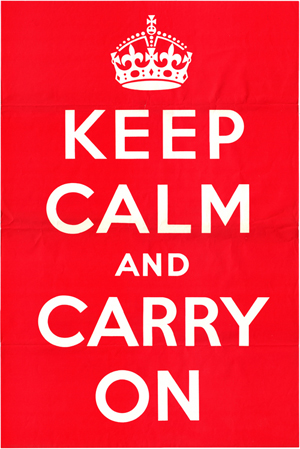Co-authored by Adam Strochak
For last year’s words belong to last year’s language
And next year’s words await another voice.
And to make an end is to make a beginning.
~T.S. Eliot~
If only the restructuring community believed T.S. Eliot’s fateful words. January’s annual Weil Restructuring Outlook Survey, taking in predictions on the upcoming year from the restructuring community at large, elicited one overwhelming consensus: Keep Calm and Carry On: 2012 is going to look much the same as 2011.
Our ten-question survey, in which over 150 restructuring professionals participated this year, was geared towards drawing out how the restructuring market viewed the global economic outlook for 2012.
Keep Calm and Carry On
Our first question asked respondents to choose the phrase that most closely reflected the outlook for 2012 from the following choices: (a) London Bridge is Falling Down; (b) Keep Calm and Carry On; (c) Four More Years. . .of Recovery; (d) 2011 Redux; (e); Getting Better All The Time; (f) Easy Money; or (g) Grow, Grow, Grow Your Boat.

Initially produced by the British Ministry of Information at the beginning of the Second World War, the “Keep Calm and Carry On” poster was designed to raise the morale of the British public in the event of an invasion.
Fifty years on, the message is still an apt one, even if it never served its original purpose. Very few respondents characterized 2012 with the words “London Bridge is Falling Down” (although perhaps the response might have been different had we referred to the Acropolis), and the view of respondents was of an upcoming year characterized by a modest recovery that was much akin to 2011.
Number of Jumbo Chapter 11 Cases
2011 saw ten jumbo chapter 11 cases (assets over $1 billion), with six of those ten cases (by size: MF Global Holdings, AMR Corp., Dynegy Holdings, PMI Group, General Maritime Corp. and Lee Enterprises) filing in the last quarter of the year. Respondents to the 2012 survey largely expected the same number of jumbo chapter 11 cases – between one and ten, with distress expected largely to be focused on the retail sector. Not one of our respondents saw any distress in the automotive sector this year, which is good news for Detroit.
Sector Analysis
Here’s what respondents thought about the prospects of distress by commercial and industrial sector. Note that the total is greater than 100% because respondents could choose three sectors.
| Probability of Distress by Sector | |
| Sector | Responses |
| Retail | 34.90% |
| Media/Communications/Publishing | 30.90% |
| Restaurants | 26.20% |
| Health Care, Medical and Pharmaceutical | 25.50% |
| Banking and Finance | 22.80% |
| Commercial Real Estate | 22.80% |
| Energy | 22.10% |
| Airlines | 20.80% |
| Homebuilding/Residential Properties | 19.50% |
| Hospitality and Gaming | 16.80% |
| Transportation | 12.80% |
| Manufacturing | 12.10% |
| Agriculture/Food | 7.40% |
| Entertainment/Sports | 7.40% |
| Telecommunications | 6.70% |
| Technology | 4.70% |
| Insurance | 3.40% |
| Personal Services | 3.40% |
| Automotive | 0.00% |
More of the Same
When asked what the 12-month global speculative-grade default rate would be as of December 21, 2012, over half of respondents expected it to end in the 2-3% range, much the same as in 2011 when it ended the year at 2.05%, down from 3.3% in 2010.
Predictions on the closing price of the Dow Jones Industrial Average were much the same. The DJIA closed out 2011 at 12,217, up 6% from 2010. By the end of 2012, respondents expected the DJIA to remain in the 12,001 to 13,000 range. Same old, same old.
Brent crude was widely expected to trade in the $100 to $110 per barrel range by the end of the year, similar to the end of 2011 when the price per barrel of Brent Crude hovered around $100. Twenty percent of respondents saw Brent Crude ending up in the $90-$100 range, and a similar number saw Brent Crude closing the year in the $111-$120 range.
The price of gold, which traded in January 2012 at around $1,657 a troy ounce, was also expected to remain flat, with nearly half of our respondents expecting it to trade between $1,501 and $1,750 a troy ounce. No need to sell Grandma’s jewelry just yet then.
When it comes to the yield on the 10-year US Treasury note on December 31, 2012, respondents were split. No one predicted last year that the yield would finish below 2%, at 1.89%. This year, the overwhelming consensus was for a steady course on this key interest rate. Half of our respondents thought the yield would end the year below 2%, with the other half expecting the yield to end the year between 2.0 to 2.5%.
Good news for the Greeks though (and for the multitude of hedge funds who have piled into Greek bonds): fully 70.9% of our respondents expected a consensual restructuring to resolve the Greek debt crisis, so anyone planning a leveraged buyout of the Acropolis can put their pitch books away for now.
The Last Hurrah!
Lastly, we asked our respondents what their view of 2012 will be. We’ll hold back those responses until the end of the year, to see if anyone of you have called it spot on, though we thought we might leave you with one last, rather lyrical, thought from one of our Bankruptcy Blog respondents:
The era of “amend and pretend” or “amend and extend” has come to an end,
and this will encourage banks to seek larger scale restructurings, increasing deal
flow for our industry.
Only time will tell. Until next year, when we measure predictions against actual results, Yia sou!*
* To those of you following the Greek debt crisis, that’s “To your health” in Greek!
Contributor(s)












